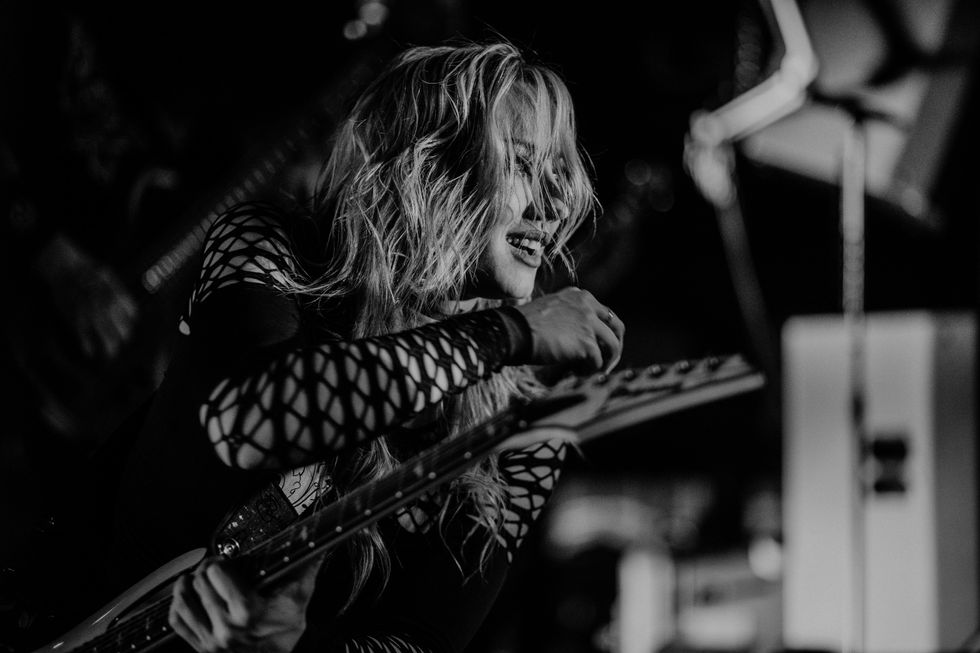It’s a fact: Women and minority artists have often been marginalized, unacknowledged, and even ripped off—both musically and financially. And while the industry has slowly gotten better about amplifying their significant contributions, white male artists have historically been heralded as the heroes and innovators. Even with all of the progress made in recent years, one niche where bias still seems the norm is “hired gun.” The commonly used term “sideman” demonstrates the pervasiveness of male-dominated norms entrenched in our collective psyche. But there are exceptional sidewomen who have broken the glass ceiling with their primetime gigs. And among the most notable are Jennifer Batten and Nita Strauss.
Batten established herself as the lead guitarist for Michael Jackson’s first solo world tour, in support of the album Bad. From 1987 to 1989, she was an integral part of Jackson’s live shows, with her distinctive guitar style and charismatic stage presence. And her 6-string prowess during performances of hits like “Beat It” and “Dirty Diana” (the former featuring Eddie Van Halen’s iconic solo on the record) displayed chops that easily rivaled her male contemporaries. Her work with Jeff Beck on his Who Else! album and subsequent tours further solidified her reputation as one of rock’s most exceptional guitarists. Though decades removed from the bright lights and big stages of those two major gigs, Batten’s career continues to thrive, and she remains an influential figure through the guitar clinics and workshops she conducts worldwide, as well as the solo albums she’s released and continues to tour behind.
Strauss famously cut her teeth with the Iron Maidens, an all-female Iron Maiden tribute band, where she performed under the stage name “Mega Murray.” In 2014, she became the touring guitarist for legendary shock-rocker Alice Cooper, replacing Orianthi, and her modern approach to shred remains the perfect foil to the more traditional classic-rock styles of her Cooper bandmates, Ryan Roxie and Tommy Henriksen. In 2018, she released her debut solo album, Controlled Chaos, which showcased her diverse range of playing styles and songwriting chops, and solidified her reputation as a formidable guitarist in the modern metal scene. In 2022, she was tapped as Demi Lovato’s touring guitarist in support of Lovato’s Holy Fvck, and just this summer Strauss released her second solo album, The Call of the Void, featuring David Draiman (Disturbed), Lzzy Hale (Halestorm), and Alissa White-Gluz (Arch Enemy), among others, as guest vocalists. During NFL football season, she has a standing gig at Los Angeles Rams home games—and a Super Bowl ring to prove it—and has also received several She Rocks awards, including “Best Guitarist” in 2018.
NITA STRAUSS - Victorious ft. Dorothy (Official Music Video)
Premier Guitar hosted a conversation with Batten and Strauss, and got some insight into their similar histories, their work to overcome the status quo, and why it might be best for aspiring guitarslingers to just “chill the fuck out.”
You share strikingly similar career trajectories. Can you give PG readers the CliffsNotes versions of your respective backgrounds?
Jennifer Batten: I started playing when I was 8 years old and, fast forward, I saw an ad in Guitar Player magazine for GIT [now the Musicians Institute]. They had a weekend symposium, and I went up and participated—three really intense days—and understood about 1 percent of what the hell they were saying. I didn’t even know a major 7th chord. In fact, one of the things they asked me to play was Gmaj7. And you know me, I know a G with a 7, first-position cowboy chord [laughs]. So, I got my ass whooped with that. By the time I got the Michael Jackson gig in ’87, I was in five or six different bands, just trying to make it in Hollywood. I got out there and played with as many bands as I could, and said “yes” to every situation until I got an audition with Michael Jackson, and then it was like zoom. I almost got seasick making that big of a jump so fast. Once you play with the biggest pop star in the world, it’s kind of like….
Where do you go from there?
Batten: Well, to Jeff Beck.
Nita Strauss: The biggest guitar star in the world. I’ve said ad nauseam that Jennifer is the one that blazed the trail for the rest of us to follow—you went through with the sword, cutting down the barricades. I took the tour at GIT three times. I could actually never afford to get in, but I grew up in L.A. playing clubs, playing in multiple different bands. I went straight from a metalcore tour in Europe, straight into Jermaine Jackson’s band, straight into an Iron Maiden tribute band, all while doing my original thing, doing covers, doing solo shows, playing acoustic guitar with singers that needed accompanists—really anybody that would have me until I got picked up by Alice Cooper in 2014. And that was my introduction to the big leagues.
Batten: When I went to GIT, class of ’79, I was the only female. And that really shocked me because I didn’t expect that. I didn’t realize it was such an odd career choice for a woman. Fifty-nine guys and me. Crazy.
Jennifer Batten's Gear

Batten has been involved in music education in the form of teaching, workshops, and instructional materials. One piece of wisdom she shares: “If you’re going to be somebody that gets hired for different shows, it’s so important to be humble and be aware of what they need, because they don’t necessarily hire you to make you shine.”
Photo by Ana Massard
Guitars
- Suhr Modern Antique
- Washburn Parallaxe PXM10
Amps & Effects
- BluGuitar AMP1
- BluGuitar NANOCAB & FATCAB
- Line 6 HX Stomp XL Multi-effects Floor Processor
- MeloAudio MIDI Commander
Amps & Strings, Picks, & Accessories
- D’Addario NYXL (.008–.042)
- Gravity 1.5 mm
- Lock-It Guitar Straps
- D’Addario XPND Pedalboard
- ASI Audio 3DME in-ear monitors
- Audix i5 Microphone with CabGrabber Mic Clamp
Were there female guitarists you could look to for inspiration or was it just the typical male guitar heroes of that era?
Batten: Yeah, it was all guys. I don’t recall thinking, “Where are the women?” My ears just went to the music that I liked. Jeff Beck was on the radio, with Blow by Blow, and that was good enough for me. I didn’t need another gender to look at.
Strauss: As a young kid getting into shred guitar, it really was a boy’s club, and I was the same way. I didn’t seek out a female guitar hero to be inspired by. I gravitated towards the players that I liked. I was into Steve Vai, Joe Satriani, Paul Gilbert, Marty Friedman, and Jason Becker. And then, when I first discovered Jennifer, it was like a kid finding a Barbie that looked like her for the first time—there was somebody like me doing it, and here she is on the biggest stage in the world with the biggest star in the world, and it’s not a chick thing. She’s playing circles around all these guys. She’s not there because she’s beautiful. She’s not there because she’s a great performer. She is all those things, but she’s there because of the technique and the performance and just delivering night after night after night. And that was my biggest thing: If she can do it, I can do it too.

Ready to shred! Strauss poses with her Ibanez Signature JIVAX2, and Batten with her steampunk-styled Washburn Parallaxe PXM10.
Photo by Ana Massard
Batten: When I joined Michael Jackson in 1987, I thought, “Now’s the revolution.” Wendy [Melvoin] & Lisa [Coleman] were already with Prince. And I thought, “Okay, a big change is happening.” And then crickets for 10 or 15 years—it was nothing. It’s almost like it took the Internet to get up to speed. Now I tell people, “Not a month goes by that I don’t see some 7-year-old girl in Indonesia who could kick my ass [laughs].”
Strauss: And what’s crazy, when I see these kids coming up hot on our heels, someone always tags me and says, “You better watch out. They’re coming for you.” And I’m like, “No, I applaud them. I lift them up. This is what we’re here for. Women elevating women.” There’s no competition. I don’t have a sense of competition with anybody else out there. I want to see us all succeed. A rising tide lifts all boats, and women succeeding in this industry is a win for everybody. This is an amazing time to do what we do.
Nita Strauss' Gear

This past summer, Strauss released her second solo album, The Call of the Void, featuring vocalists David Draiman (Disturbed), Lzzy Hale (Halestorm), and Alissa White-Gluz (Arch Enemy), among others.
Photo by Ana Massard
Guitars
- Ibanez Signature JIVAX2
- Ibanez Signature JIVA10
- Custom Ibanez Signature JIVAJR
Amps & Effects
- Boss GT-1000 Effects Processor
- Kemper Profiler
Strings & Picks
- D’Addario NYXLs (.010–.046)
- Grover Allman .60 mm
Can you share how playing smaller venues on your own helps you continue to evolve as yourself, versus the big arena gigs?
Batten: The only place you really get satisfaction is when you’re improving as a player. Nobody can take that away from you. Whether you’re doing great, or not so great, as far as the worldview—are you famous this week? Every once in a while, I get people going, “I didn’t know you were still playing.” Well….
Strauss: Well, here I am.
Batten: Michael Jackson’s been gone for quite a while, and I haven’t played with Jeff Beck in 20 years. I’m doing my thing on my level and still putting in as many frequent flier miles as I ever did.
Strauss: The mark of a great hired gun, no matter who you’re playing with, is that you maintain your own style, but you’re always able to execute that person’s vision. Whether I’m going out with Alice, or I’m going out with Demi, you can tell that it’s me on stage, but I’m not going to play the same way that I would with my solo band.
Batten: If you’re going to be somebody that gets hired for different shows, it’s so important to be humble and be aware of what they need, because they don’t necessarily hire you to make you shine. When I got the Jeff Beck gig, he was always going, “I should really give you 10 minutes on your own.” And I said, “Hell no [laughs].”
Jennifer Batten - Whatever
Strauss: You have to strike out on your own, especially when the majority of what people know you as “so and so’s guitar player.” You really have to take that stand and say, “I’m not only someone’s guitar player, I’m also my own identity. I have my own creativity. I have my own vision.” The only time that you have to really flex and be creative is when you’re doing your own thing. You’re not executing anybody’s vision but your own, so I think it’s super valuable.
Do either of you take a different approach to the craft when playing with other guitar players?
Batten: Jeff [Beck] is one of those guys—jump and a net will appear. The first time I played with him, I’ll never forget walking into the room expecting a keyboard player, because ever since the ’70s, he had keyboards. And I thought, “Man, this is not going to cut it.” All these songs that I grew up listening to, like “Cause We’ve Ended as Lovers,” have these lush keyboard backgrounds. So, I took it upon myself to dive deep into guitar synthesizer because I thought those pads were necessary. Like we said before, you’ve got to realize what’s needed. I was there to support.
Strauss: I love to play with Ryan [Roxie] and Tommy [Henriksen]. I think it just fills out the sound so much, and we’ve been playing together for so long that we mesh. We even have this brain-meld where our vibrato syncs up in a way that we don’t plan. So, I think once you play with people for a while, you get sensitive to their tendencies. We don’t even really go over parts before the tour anymore. When you play with people for a long time, you just get a good sense of what they’re going to do.

Both guitarists have worked high-profile, hired-gun gigs while maintaining their own solo careers. “The only place you really get satisfaction is when you’re improving as a player,” says Batten.
Photo by Ana Massard
How important is music education to both of you?
Batten: It’s fun to show people stuff that you’ve learned. There’s an energy that just creates momentum. I’ve done a ton of teaching since my early days, and granted, most of the students don’t want to work, but when you get somebody that’s really into it, the momentum really grows.
Strauss: Just throw them in the deep end of the pool and say, “Figure it out kid, I did [laughs].”
Batten: I give them too much information. I send them PDFs and videos and all this crap that’s enough for six months of work. It’s no wonder they don’t come back every week [laughs].
Strauss: They’re like, “This guitar shit looked like fun, but it’s hard [laughs].” I taught myself how to play by watching DVDs, like Jennifer’s, and I had all the REH instructional videos, all the Shrapnel albums. I learned modes from Frank Gambale’s Modes: No More Mystery and Melodic Control by Marty Friedman. I don’t teach one-to-one, but I do clinics. I have an online course called Rock Guitar Fundamentals. I’ve done my Guitar World and Premier Guitar columns [and interviews], and I think that the way that I teach is really understandable because I’m stupid and I didn’t have anybody teach me [laughs]. I approach it from a very practical standpoint because I had to figure it out myself.
I know you each have creative outlets other than guitar. I’m curious about how that influences your music.
Batten: When I moved to Portland 20 years ago, I took stained glass classes, and I just went bonkers with it. But I moved on from doing glass art to steampunk art. One day I woke up and said, “Gears, I must work with gears,” and I started making these fantasy airships from junk. It’s a really fun place to be. When you get back to music, it’s a lot fresher and energizing. If I can focus on visual arts, I find that a real charge because it’s all the same muscle, it’s all creativity. And I find one muscle helps the other, as the workout queen will tell you [laughs].
Strauss: The workout stuff and the Body Shred challenge [an eight-week fitness challenge created by Strauss] isn’t as much of a creative outlet as a mental health outlet—the better you take care of the machine, the better the machine runs. And when I first started getting healthier and more involved in fitness, I lost some weight, I got sober, and people around me started asking, “What did you do?” I found myself writing Instagram captions and comments. When we created the Body Shred challenge, it was a way to get our community, the guitar and the rock and heavy metal community, more incentivized to get healthier and fit.

Strauss and Batten have outside passions that help fuel their creativity. Strauss does yoga and has her eight-week Body Shred challenge. Batten does steampunk-inspired art.
Photo by Ana Massard
Do either one of you have a secret weapon that isn’t overtly obvious to the average listener or concertgoer that is essential for you when performing?
Batten: I’d say a tremolo. I mean, it should be called an “expression bar” more than a “whammy bar,” but that’s a must-have.
Strauss: Same answer. I’ve gotten to the point where I do a lot of my vibrato with the bar, as a different color tone. When you get up into a really high bend and you get the vibrato on the bar, it gives you a little extra oomph.
Batten: The bar lets you go sharp and flat as opposed to a finger vibrato that’s only sharp. So, it’s not as rounded-sounding. I love it.
Has traveling, whether by air or bus, affected your gear choices?
Batten: My gear is super simple at this point. I’ve been using a Line 6 HX Stomp XL. It’s like I have 30 pedalboards that I can kick into at a moment’s notice. Now, everything I need for sound is in my carry-on. It’s a little heavy to carry, but at least I know, worst-case scenario, I have to borrow or rent a guitar and grab somebody’s jacket, so I don’t look like a hippie [laughs].
Strauss: My rig is so simple. I was a very early adopter of the multi-effect units, so my first pedal ever was a Zoom 505. Now, my touring rig is a Boss GT-1000 direct into the house. I have my tone super dialed into it, and I’m in the mindset of if it’s not broken, I don’t try to fix it. I’m not on a quest for tone unless my tone’s not good. And I love my tone with that pedalboard. They make a palm size one, the GT-1000 Core, so I can throw that in any gig bag and travel all over the world.
Jennifer, do you have a favorite piece of advice that you would give a young guitar player that wants to follow in your footsteps? Asking for a friend [laughs].

Shredding with a smile—Nita Strauss on stage earlier this year.
Photo by Ana Massard
Batten: I remember the angst and the pressure I put on myself to “make it.” And if the record doesn’t do it, my life’s over—that kind of bullshit. As long as you can plant a seed that the only thing that matters is getting better as a musician, things will happen as you put that energy out into the universe. I don’t think you need to stress, as long as you’re spending time with the instrument every day and playing with different people and doing a lot of listening. There’s so much that you can’t control. At the end of the day, if you’re getting better, that’s all that matters. I think the best compliment I’ve ever been given is if somebody comes up to me after a show and says it was inspiring. I go, “Man, that’s the shit.” Because when I go to a show, that’s what I want to get out of it. So that’s my advice. Chill the fuck out.
Strauss: Amen.














 Zach loves his Sovtek Mig 60 head, which he plays through a cab he built himself at a pipe-organ shop in Denver. Every glue joint is lined with thin leather for maximum air tightness, and it’s stocked with Celestion G12M Greenback speakers.
Zach loves his Sovtek Mig 60 head, which he plays through a cab he built himself at a pipe-organ shop in Denver. Every glue joint is lined with thin leather for maximum air tightness, and it’s stocked with Celestion G12M Greenback speakers.


















![Devon Eisenbarger [Katy Perry] Rig Rundown](https://www.premierguitar.com/media-library/youtube.jpg?id=61774583&width=1245&height=700&quality=70&coordinates=0%2C0%2C0%2C0)








 Luis Munoz makes the catch.
Luis Munoz makes the catch.









